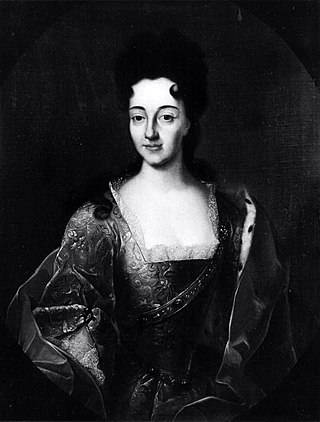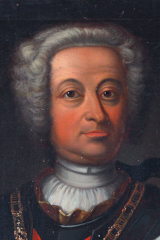Related Research Articles

The House of Leiningen is the name of an old German noble family whose lands lay principally in Alsace, Lorraine, Saarland, Rhineland, and the Palatinate. Various branches of this family developed over the centuries and ruled counties with Imperial immediacy.

Maurice of Hesse-Kassel, also called Maurice the Learned or Moritz, was the Landgrave of Hesse-Kassel in the Holy Roman Empire from 1592 to 1627.

Constantine Josef, Hereditary Prince of Löwenstein-Wertheim-Rosenberg, was the eldest son and heir of Charles Thomas, Prince of Löwenstein-Wertheim-Rosenberg and his wife, Sophie of Windisch-Graetz. He died before his father.
Dominic Marquard, Prince of Löwenstein-Wertheim-Rochefort was the second Prince of Löwenstein-Wertheim-Rochefort.

The mini-state Hesse-Wanfried existed from about 1700 to 1731. It was a principality (Landgraviate) of the Holy Roman Empire in the area of the today's Land of Hesse. Governed by a cadet line of the House of Hesse under the sovereignty of the land of Hesse-Kassel.

Johann Ernst of Nassau-Weilburg was an Imperial Generalfeldmarschall, from 1675 to 1688 Count and from 1688 until his death Prince (Fürst) of Nassau-Weiburg.

Theodore Eustace(German: Theodor Eustach; 14 February 1659 – 11 July 1732) was the Count Palatine of Sulzbach from 1708 until 1732.

Count Christian Karl Reinhard of Leiningen-Dagsburg-Falkenburg was a German nobleman.

Princess Maria Eleonore of Hesse-Rotenburg was Landgravine of Hesse-Rotenburg by birth and was the Countess Palatine of Sulzbach by marriage. She is an ancestor of Albrecht, Duke of Bavaria.
Johann Karl August, Count of Leiningen-Dagsburg-Falkenburg was a German nobleman. By descent, he was Count of Leiningen and Dagsburg, by heritage, he was Lord of Broich and Bürgel.
Countess Johanna Magdalene of Hanau-Lichtenberg was a daughter of Johann Reinhard II of Hanau-Lichtenberg (1628–1666) and the Countess Palatine Anna Magdalena of Birkenfeld-Bischweiler (1640–1693).

Countess Juliane of Nassau-Siegen, German: Juliana Gräfin von Nassau-Siegen, official titles: Gräfin zu Nassau, Katzenelnbogen, Vianden und Diez, Frau zu Beilstein, was a countess from the House of Nassau-Siegen, a cadet branch of the Ottonian Line of the House of Nassau, and through marriage landgravine of Hesse-Kassel.

William I, Landgrave of Hesse-Rotenburg was from 1683 until his death Landgrave of Hesse-Rotenburg. He was a son of Ernest I of Hesse-Rotenburg-Rheinfels and his wife, Countess Maria Eleonore of Solms-Lich. William was nicknamed the Elder to distinguish him from his nephew, William of Hesse-Wanfried.
William II, Landgrave of Hesse-Wanfried-Rheinfels was a son of the Landgrave Charles of Hesse-Wanfried (1649–1711) and his first wife, Countess Sophie Magdalene of Salm-Reifferscheid. He succeeded his father as Landgrave of Hesse-Wanfried and Hesse-Rheinfels. After 1711, he styled himself "Landgrave of Hesse-Rheinfels".

Landgrave Frederick of Hesse-Eschwege was from 1632 until his death Landgrave of the apanage of Hesse-Eschwege, which stood under the suzerainty of Hesse-Kassel.
Christian of Hesse-Wanfried-Rheinfels was a son of Landgrave Charles of Hesse-Wanfried (1649–1711) and his second wife, Countess Alexandrine Juliane of Leiningen-Dagsburg (1651–1703). He was Landgrave of Hesse-Wanfried and Hesse-Rheinfels from 1731 until his death.

Landgrave George III of Hesse-Itter was the second son of Landgrave George II of Hesse-Darmstadt and his wife Sophia Eleonore of Saxony (1609–1671). Since he left no male heir, Hesse-Itter fell back to Hesse-Darmstadt.

Charles Thomas, 3rd Prince of Löwenstein-Wertheim-Rochefort was from 1735 to 1789 the third Prince of Löwenstein-Wertheim-Rochefort.

Princess Charlotte Amalie of Hesse-Wanfried was a Princess consort of Transylvania as the wife of Francis II Rákóczi.
References
- Chronik der Stadt Wanfried, Reinhold Strauß, 1908
- Eckhart G. Franz, Das Haus Hessen, Stuttgart, 2005, ISBN 3-17-018919-0